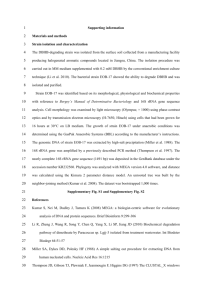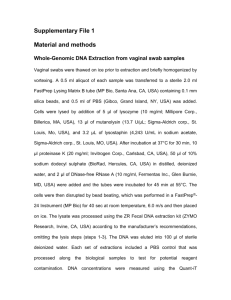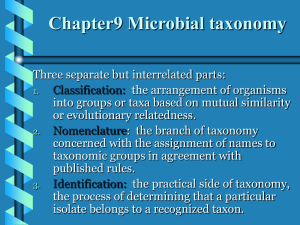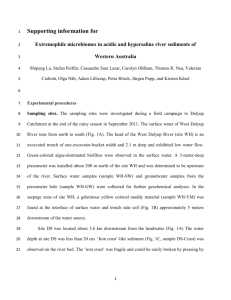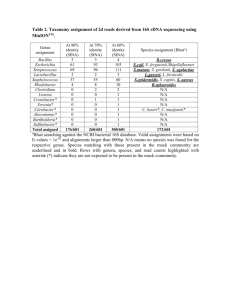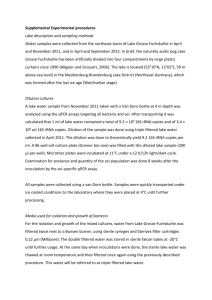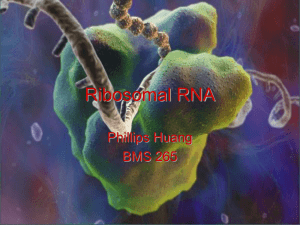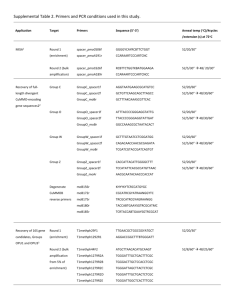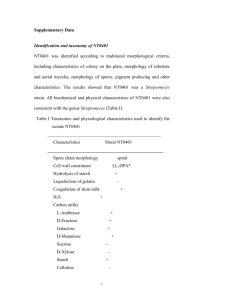emi412183-sup-0001-si
advertisement
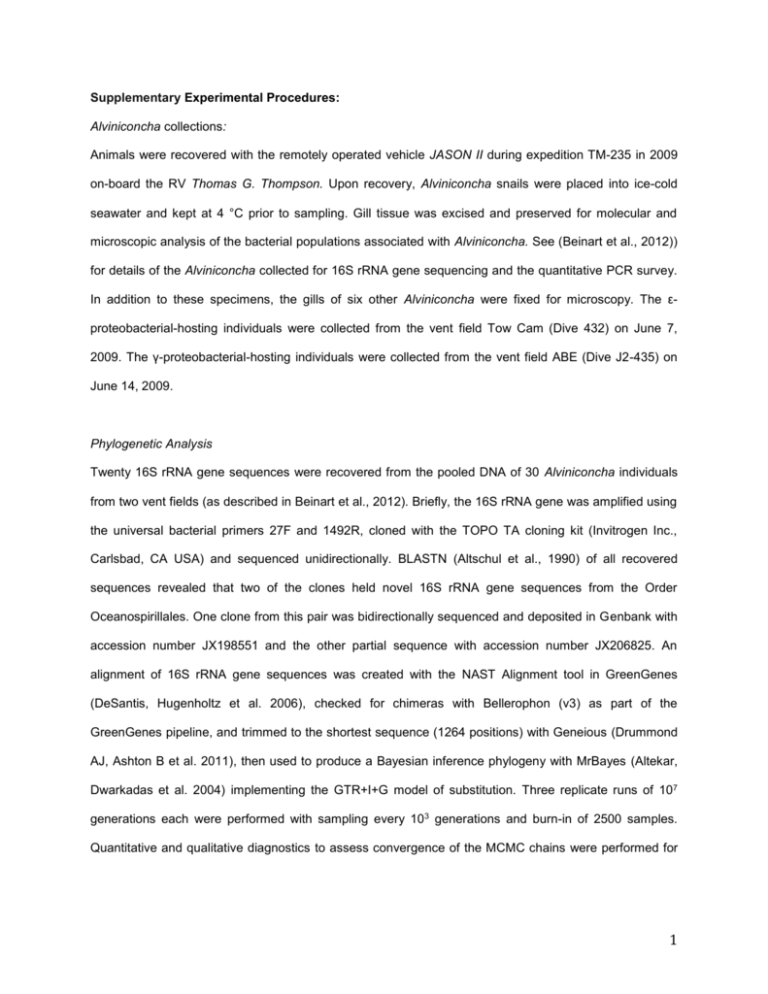
Supplementary Experimental Procedures: Alviniconcha collections: Animals were recovered with the remotely operated vehicle JASON II during expedition TM-235 in 2009 on-board the RV Thomas G. Thompson. Upon recovery, Alviniconcha snails were placed into ice-cold seawater and kept at 4 °C prior to sampling. Gill tissue was excised and preserved for molecular and microscopic analysis of the bacterial populations associated with Alviniconcha. See (Beinart et al., 2012)) for details of the Alviniconcha collected for 16S rRNA gene sequencing and the quantitative PCR survey. In addition to these specimens, the gills of six other Alviniconcha were fixed for microscopy. The εproteobacterial-hosting individuals were collected from the vent field Tow Cam (Dive 432) on June 7, 2009. The γ-proteobacterial-hosting individuals were collected from the vent field ABE (Dive J2-435) on June 14, 2009. Phylogenetic Analysis Twenty 16S rRNA gene sequences were recovered from the pooled DNA of 30 Alviniconcha individuals from two vent fields (as described in Beinart et al., 2012). Briefly, the 16S rRNA gene was amplified using the universal bacterial primers 27F and 1492R, cloned with the TOPO TA cloning kit (Invitrogen Inc., Carlsbad, CA USA) and sequenced unidirectionally. BLASTN (Altschul et al., 1990) of all recovered sequences revealed that two of the clones held novel 16S rRNA gene sequences from the Order Oceanospirillales. One clone from this pair was bidirectionally sequenced and deposited in Genbank with accession number JX198551 and the other partial sequence with accession number JX206825. An alignment of 16S rRNA gene sequences was created with the NAST Alignment tool in GreenGenes (DeSantis, Hugenholtz et al. 2006), checked for chimeras with Bellerophon (v3) as part of the GreenGenes pipeline, and trimmed to the shortest sequence (1264 positions) with Geneious (Drummond AJ, Ashton B et al. 2011), then used to produce a Bayesian inference phylogeny with MrBayes (Altekar, Dwarkadas et al. 2004) implementing the GTR+I+G model of substitution. Three replicate runs of 107 generations each were performed with sampling every 103 generations and burn-in of 2500 samples. Quantitative and qualitative diagnostics to assess convergence of the MCMC chains were performed for 1 each of the three runs using the Coda package in R (Plummer, Best et al. 2006), the three replicate runs were combined and a 50% majority rule consensus tree was created in MrBayes. Fluorescence in situ hybridization An oligonucleotide FISH probe (AOP 5'CCGTACTCCAGCCACCCA) targeting the AOP 16S rRNA gene sequences was created by modifying the FISH probe Bnix643 that was previously designed to target the closely related Oceanospirillales found to infect the vent mussels of the genus Bathymodiolus (Zielinski et al., 2009). Specific hybridization conditions (described below) for the AOP probe were found by varying the concentration of formamide in the hybridization buffer in 10% increments from 10% - 40%. 30% was chosen because it maximized AOP-probe stringency and was compatible with the other probes used in dual-labeling. Dual FISH hybridizations were performed using the Cy3-labeled, AOP-specific probe and Cy5labeled, universal bacterial EUB338(I-III) probes (Amann et al., 1990). Subsamples of Alviniconcha gill tissues were fixed for 12-24 hours at 4°C in 1X phosphate buffered saline (PBS: 137 mM NaCl, 2.7 mM KCl, 10 mM Na2HPO4, 2 mM KH2PO4) containing 2% paraformaldehyde. Gill samples were subsequently washed three times in 1X PBS, transferred to storage solution of equal parts 1X PBS and ethanol and kept at 4°C until embedding. Gill samples were dehydrated in an ascending ethanol series, washed twice in xylene, then embedded in paraffin. Paraffin blocks were sectioned with a microtome into 5 μm thick sections. The sections were placed onto Super-Frost slides (Fisher Scientific, Waltham, MA USA), dewaxed in three successive baths of xylene for 10 min each and a descending ethanol series (96%, 80%, 70%, 50%) for 5 min each and finally air dried. Each section was circled with a wax pen (PAP-pen, Kisker Biotech, Steinfurt, Germany), then covered with 30% formamide hybridization buffer (Pernthaler et al., 2002) containing fluorescently labeled oligonucleotide probes (5 ng μl-1 final concentration). Hybridization was conducted for 3 hrs at 46°C, and washing, DAPI staining and mounting of sections on slides was performed as in (Jillian et al., 2010). Negative controls to account for background autofluorescence were performed with NON338 (not shown) (Wallner et al., 1993). Sections were examined and photographed using the fluorescence microscope Axioskop2 mot plus (Carl Zeiss, Inc., Göttingen, Germany). The ImageJ software plugin DeconvolutionLab (Vonesch and Unser, 2008) was 2 used for deconvolution of the images, and ImageJ used for contrast adjustment, and assignment of colors to the different wavelengths. Transmission Electron Microscopy Subsamples of the paraformaldehyde fixed gills (see FISH preservation) were post-fixed in a solution of 1% osmium tetroxide and 0.8% potassium ferricyanide in 0.1M sodium cacodylate with 0.375M NaCl for 1.5 hr at 4°C, then washed in distilled water, dehydrated through an ascending ethanol series, cleared in 100% acetone, and embedded in an epoxy mixture of Embed 812 (Electron Microscopy Sciences, Hatfield, PA USA) and Araldite 506 (Ernest Fulham Inc., Albany, NY USA). Thin sections (80 nm) were obtained using a diamond knife on a LKB Ultramicrotome V followed by staining with 2% uranyl acetate and Reynold’s lead citrate, and viewed with a FEI Tecnai Biotwin G2 Spirit electron microscope (Hillsboro, OR USA) operated at 80 kV. The contrast of the micrographs was adjusted in Adobe Photoshop Elements. Quantitative PCR Survey A SYBR-green quantitative PCR (qPCR) assay was designed to target the AOP 16S rRNA genes. QPCR was performed with the primers AOP-F (5' TTTCCAGAGATGGATGGGTGCCTT) and AOP-R (5' ACCCAAAGTGCTGGTAACTGAGGA). Primers were designed and checked for specificity by comparison to all available 16S rRNA gene sequences with Primer-BLAST (Rozen and Skaletsky 1999). All assays were performed on a Stratagene MX3005p sequence detector (Stratagene Inc., La Jolla, CA USA) in 96well optical grade plates and seals. The assay was optimized using standard curves created from linearized plasmids (pCR2.1, Invitrogen, Carlsbad, CA USA) with the AOP 16S rRNA gene inserted (same clone used in phylogenetic analysis) and the resulting average amplification efficiency of the standard curve was 89% (±0.04% SD). These standard curves spanned seven orders of magnitude and were designed to allow the addition of 101 – 107 gene copies as 2 µl of template in each PCR reaction. To quantify the number of AOP 16S rRNA gene copies in gill DNA from 283 Alviniconcha individuals, 2 µl of diluted DNA (1:100) was used as template in 20 µl reactions, with a final concentration of 1 × Perfecta SYBR Green FastMix, low ROX (Quanta BioSciences, Gaithersburg, MD USA) and 300 μM primers. PCR 3 cycling conditions were as follows: 3 min at 95°C, then 40 cycles of 30 s at 95°C, 1 min at 65°C and 30 s at 72°C, with a final dissociation curve performed to check for specificity of amplification. Data analyses were carried out with the sequence detection system software MXPro (Stratagene Inc., La Jolla, CA USA). Via tests against plasmid-based standard curves containing the 16S rRNA genes of the other Alviniconcha symbiont phylotypes, the AOP-specific qPCR assay was found to cause slight non-specific amplification with the 16S rRNA gene of the Alviniconcha symbiont γ-Lau. The maximum number of γ-Lau 16S rRNA gene copies, in any given sample, was on the order of 106, which we found would result in non-specific amplification equal to that of 10 copies of AOP. Therefore, to ensure that the number of AOP 16S rRNA gene copies was not overestimated due to this non-specific amplification, 10 copies were subtracted from the AOP counts for all samples. Additionally, all samples were also tested for amplification inhibition, as previously reported in (Beinart et al., 2012)into γ-1 qPCR reactions with DNA from each Alviniconcha individual sample. An increase in the Ct of this reaction relative to the Ct resulting from 104 copies of the γ-1 plasmid alone indicated amplification inhibition and the abundance of detected AOP 16S rRNA genes in the original was adjusted for sample efficiency as in Beinart et al., 2012. Finally, to determine the relative abundance of AOP in each Alviniconcha individual, AOP rRNA gene copies were compared to the abundances of the three symbiont phylotypes’ 16S rRNA genes that had previously been determined with qPCR (Beinart et al., 2012). Supplementary Results: Table S1: Number of Alviniconcha individuals in which AOP was detected/not detected via 16S rRNA gene qPCR according to their majority symbiont phylotype (ε, ε-proteobacteria; γ-1, γ-proteobacteria type I; γ-Lau, γ-proteobacteria type Lau, γ-1/ γ-Lau, equal proportions of both) and host type (HT-I, -II, -III and UD, undetermined). NA, not applicable because no individuals of this host type/symbiont combination were observed. HT-I HT-II HT-III HT-UD All ε 2/4 3/85 NA 0/8 5/97 γ-1 88/5 NA 28/1 7/0 123/6 γ-Lau NA NA 39/2 3/0 42/2 γ-1/ γ-Lau NA 90/9 NA 3/85 7/0 74/3 1/0 11/8 8/0 178/105 All Table S2: Proportion of AOP 16S rRNA genes, relative to the 16S rRNA genes of the symbionts, in Alviniconcha individuals according to their majority symbiont phylotype (ε, ε-proteobacteria; γ-1, γproteobacteria type I; γ-Lau, γ-proteobacteria type Lau, γ-1/ γ-Lau, equal proportions of both) and host 4 type (HT-I, -II, -III and -UD, undetermined). Percentages as median (minimum, maximum) are shown, followed by the number of individuals (n) of each host type/symbiont combination. HT-I HT-II HT-III HT-UD All % AOP n %AOP n %AOP n %AOP n %AOP n ε 0 (0,7.5) 6 0 (0, 2.5) 88 NA* 0 0 (0,0) 8 0 (0, 7.5) 102 γ-1 1.6 (0,36) 93 NA* 0 1.3 (0,9.9) 29 1.9 (0.09,22) 7 1.5 (0, 36) 129 γ-Lau NA* 0 NA* 0 0.94 (0,15) 41 1.8 (0.99,1.9) 3 1.0 (0,15) 44 γ-1/ γ-Lau NA* 0 NA* 0 0.79 (0.06,1.9) 7 0.49 1 0.64 (0.06,1.9) 8 All 1.5 (0, 36) 99 0 (0, 2.5) 88 1.2 (0,15) 77 NA** 19 0.53 (0, 36) *not applicable because no individuals of this host type/symbiont combination were found. **not applicable because undetermined hosts may be multiple host types and should not be combined. Table S3: Proportion of AOP 16S rRNA genes, relative to the 16S rRNA genes of the symbionts, in Alviniconcha individuals at the four vent fields at the ELSC according to their majority symbiont phylotype (ε, ε-proteobacteria; γ-1, γ-proteobacteria type I; γ-Lau, γ-proteobacteria type Lau, γ-1/ γ-Lau, equal proportions of both) and host type (HT-I, -II, -III and -UD, undetermined). Percentages are shown as median (minimum, maximum), followed by the number of individuals in brackets. NA, not applicable because no individuals of this host type/symbiont combination were found at that vent field. The predominant host type/symbiont phylotype combination for each vent field is shaded in gray. Host Symbiont Kilo Moana Tow Cam ABE Tu'i Malila HT-I ε γ-1 0 0 (0,0) [4] 0 (0,0) [4] 4.5 (1.4,35) [3] 3.9 1.9 (0,36) [56] NA 1.5 (0,22) [30] HT-II ε 0 (0,0) [28] 0 (0,2.5) [53] 0 (0,0) [7] NA HT-III γ-1 γ-Lau γ-1/γ-Lau NA NA NA NA NA NA 1.2 NA NA 1.3 (0,9.9) [28] 0.94 (0,15) [41] 0.80 (0.06,1.9) [7] HT-UD ε γ-1 0 (0,0) [2] NA 0 (0,0) [4] NA 0 (0,0) [2] 1.9 (0.09, 22) [5] NA 3.3 (1.5, 5.1) [2] γ-Lau γ-1/γ-Lau NA NA NA NA NA NA 1.8 (0.99,1.9) [3] 0.49 All 0 (0,0) [35] 0 (0,35) [64] 1.5 (0,36) [72] 1.3 (0,22) [112] All 5 283 Supplementary References: Altschul,S.F. et al. (1990) Basic local alignment search tool. Journal of Molecular Biology 215: 403–410. Amann,R.I. et al. (1990) Combination of 16S rRNA-targeted oligonucleotide probes with flow cytometry for analyzing mixed microbial populations. Appl. Environ. Microbiol. 56: 1919–1925. Beinart,R.A. et al. (2012) Evidence for the role of endosymbionts in regional-scale habitat partitioning by hydrothermal vent symbioses. Proceedings of the National Academy of Sciences. Jillian,M.P. et al. (2010) Dual symbiosis of the vent shrimp Rimicaris exoculata with filamentous gamma‐ and epsilonproteobacteria at four Mid‐Atlantic Ridge hydrothermal vent fields. Environ. Microbiol. 9999:. Pernthaler,A. et al. (2002) Fluorescence In Situ Hybridization and Catalyzed Reporter Deposition for the Identification of Marine Bacteria. Appl. Environ. Microbiol. 68: 3094–3101. Vonesch,C. and Unser,M. (2008) A fast thresholded Landweber algorithm for wavelet-regularized multidimensional deconvolution. Image Processing. Wallner,G. et al. (1993) Optimizing fluorescent in situ hybridization with rRNA-targeted oligonucleotide probes for flow cytometric identification of microorganisms. Cytometry 14: 136–143. Zielinski,F.U. et al. (2009) Widespread occurrence of an intranuclear bacterial parasite in vent and seep bathymodiolin mussels. Environ. Microbiol. 11: 1150–1167. 6

